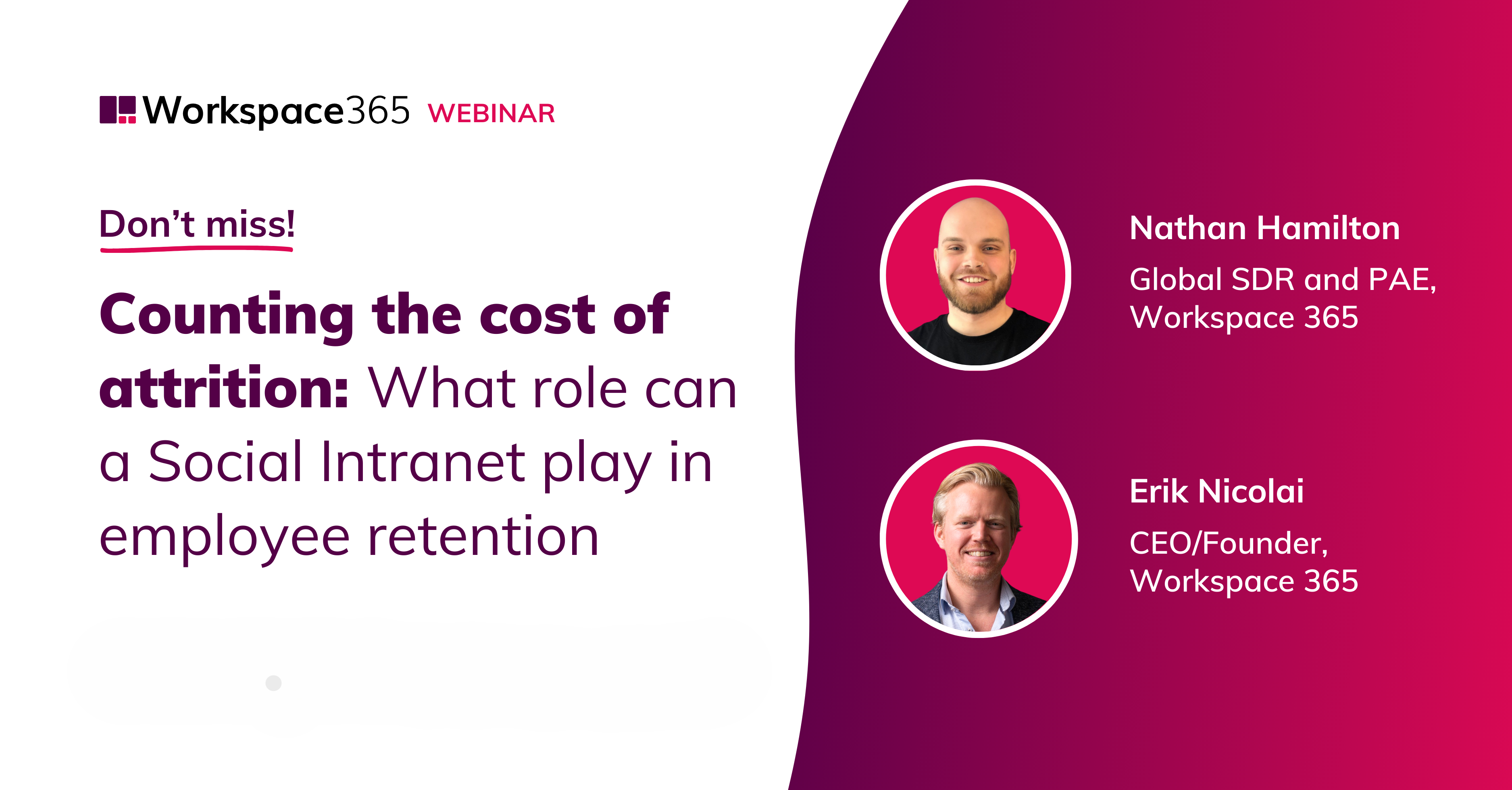Digital employee experience (or DEX) is rapidly growing in importance. More and more organisations are both using the term and exploring the concept behind it, analysing their overall employee experience, but also focusing more specifically on the digital element.
Digital employee experience is crucial because it can impact employee engagement, efficiency and productivity. In turn, this affects everything from employee turnover to profitability. In this article, we’re going to look at what exactly the digital employee experience is, and cover ten tips for improving it.
What is the Digital Employee Experience (DEX)?
Customers often ask us: “What is DEX?”. At a high level, digital employee experience is the way your employees experience workplace technology. It takes a holistic, strategic and joined-up view of all the digital touchpoints that employees have with their employer over the time they are working for an organisation. It also considers technology from the view of the employee – a good digital employee experience is centred around their needs. A simpler way to think about it is the ‘digital’ part of overall employee experience.
Although there is agreement over the general meaning of DEX, there is no consensus of a more specific definition. Different interpretations of digital employee experience have slightly varying emphases; for example, positioning the concept as the equivalent to ‘customer experience’ but applied to employees, or as the digital experience provided to employees throughout the employee lifecycle, from onboarding to when they leave. In truth, what constitutes ‘digital employee experience’ will vary from organisation to organisation.
What are the elements that impact DEX?
A variety of different factors need to be considered in delivering DEX. These include:
- The ability to drive efficiency and allow employees to get things done quickly
- Easy-to-use and intuitive interfaces.
- Avoiding information overload by not having an overwhelming number of apps or systems to access.
- Effortless workflows that enable the smooth flow of knowledge through the organisation.
- The ability to work from anywhere, anytime and on any device.
- Technology which is relevant to the needs of a diverse workforce.
- Tools which aid in ‘moments that matter’, such as employee onboarding.
- Communication and collaboration tools that give everybody a voice.
- Good findability so employees can find what they need.
10 tips to improve the digital employee experience
There are many tactics and approaches to help you deliver a strong DEX that keeps on getting better and better. Here are ten tips to do just that.
1. Research the needs of the employees
Perhaps the most important approach to take when making sure you establish a great DEX is to have a thorough understanding of how employees use technology and what they need from it. What are the key tasks they need to complete? What are their pain points? What works well? How do their needs change over the day? What works and what doesn’t? How do they feel, both consciously and subconsciously? To be able to design a strong digital employee experience, you need to know your employees and the way they work.
Here, extensive and ongoing user research is key. There are a variety of different techniques you can use to do this, including surveys, data analytics, interviews, workshops, observations, usability testing, activity logging and more. From here, you can map user journeys, establish personas and use prototypes to further design a digital employee experience that is going to make a real difference.
2. Focus on a modern, digital mindset
When designing around digital employee experience, it’s always worth remembering that employee expectations are shaped by their digital experiences outside work in their usage of mobile apps, social media and digital assistants. They search using Google, buy items from Amazon and watch movies on Netflix. They want their experiences of digital workplace technology to be similar to and as modern as their ‘consumer’ experiences. In practical terms, this is not always possible, but it really helps to aspire to design a digital employee experience that will appeal to a modern digital mindset.
3. Target your efforts to different and diverse groups
Most organisations have a highly diverse workforce with different needs. What constitutes a good digital employee experience for one group will not be the same for another. One size definitely does not fit all!
Therefore, it is critical to make sure that your efforts to deliver a digital employee experience are personalised and targeted as far as possible to each individual and their needs. Here, personas based on user research and some ability for individual employees to configure their own experience of technology can be very important. For example, the ability to deliver highly personalised experiences in Workspace 365 has proved to be a powerful factor in ensuring good DEX.
4. Establish the right governance frameworks and processes
Delivering and improving the digital employee experience always requires co-ordination and management in the background, so it’s important to set up the right governance frameworks and processes that support a strong DEX. These include:
- Having the right foundational principles to ensure data privacy and security.
- Having design and brand standards in place to establish continuity.
- Implementing processes to enable integration of new technologies into your digital employee experience.
- Establishing clear ownership and responsibilities for aspects of your digital workplace.
Governance is a huge topic in itself, but should always be kept in mind.
5. Empower your employees by giving them responsibility
A good overall employee experience will ensure that individual employees feel that they are trusted and that their voice matters. This principle should be reflected in digital employee experience, too. Empowering your employees to use digital tools creatively and in their own way to meet their individual needs is essential.
Collaboration and communication tools are a significant element of any digital workplace; give your employees enough responsibility, autonomy and choice in using these tools in order to work in their own way and exercise their voice.
6. Use systems that support your digital processes
One of the jobs of a strong digital employee experience is to help employees get things done and complete tasks quickly and efficiently, removing pain points, lifting barriers and establishing clarity. In improving your digital employee experience, it greatly helps to focus on the right use cases and ensure you are working with the systems that support some of your key organisational processes.
For example, an HR system like Workday might support your key HR and talent management processes; Salesforce and Dynamics are likely at the center of your sales and marketing activity; you may use an organisational Enterprise Resource Management system; your IT or HR helpdesk might use ServiceNow; you’re likely to be using Microsoft Teams.
If you work towards improving the digital employee experience, such as by creating a single digital workspace that provides access across your digital ecosystem or building integrations and workflows, make sure the right systems are in scope.
7. Have the right digital infrastructure to support improvement
Having the right digital infrastructure and set-up to configure and manage a developing digital employee experience is critical. For example, with heavily customised portals or intranets that are designed to provide a single place for employees to access the tools and content they need, it can be difficult and expensive to make even small improvements.
A cloud-based environment which you can easily configure to make small iterative changes in response to employee feedback is going to make it easier for you to support ongoing improvement. This is something we have observed with our customers who tell us the configurability of the Workspace 365 platform is a strength in helping them focus on DEX.
8. Involve employees in the digital development process
A good tip for improving your digital employee experience is to involve your employees in the digital development process. This can be done in several different ways, including using employee feedback to shape improvements, getting them involved in testing and even asking them to act as digital champions to promote adoption with their peers.
Involving employees has three main advantages:
- You get great data so you can focus on improvements that actually make a difference.
- You can drive employee buy-in which helps to fuel adoption.
- It can help drive a culture of innovation and improvement, as well as an agile mindset.
9. Keep digitally evolving
We live in a fast-paced and unstable world in which change is a constant. The COVID-19 pandemic has shown how the priorities of both organisations and employees can change almost overnight. Organisations are constantly restructuring, technology moves on at a pace and the expectations of employees around digital employee experience can also change rapidly, influenced by the apps they use outside work.
All this means that it is imperative to keep on digitally evolving, introducing new functionality, tweaking existing capabilities and ensuring you are meeting the needs and expectations of employees. This is easier said than done, and requires elements such as agile processes, feedback loops and a digital-first mindset to ensure your digital employee experience keeps up with employee needs.
10. Don’t forget findability and content
When considering Digital Employee Experience, many teams focus on the tools deployed and the user experience. Two other important factors not to forget are content and findability. The content that people consume is a really important part of digital employee experience – if it is relevant, helpful and engaging, then it will be doing something right.
Findability is also key – can people easily find the apps and information they need either through searching or browsing? There is nothing more frustrating for employees than wasting time not being able to find what they need at the moment they need it. When considering improvements for DEX, always make sure you include content and searching within your scope.
Always focus on DEX!
Digital Employee Experience is essential in supporting great adoption, productivity, engagement and more. It’s a significant component of the way we experience work, especially with the current emphasis on hybrid working, and a digital workspace like Workspace 365 can make all the difference.







